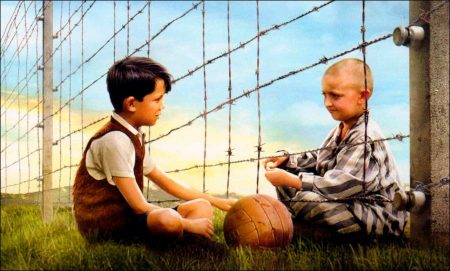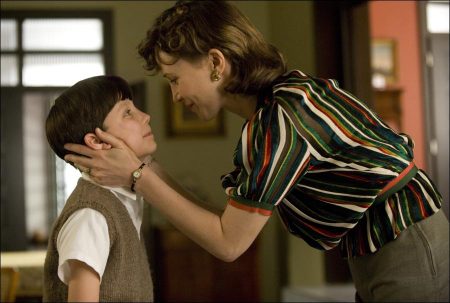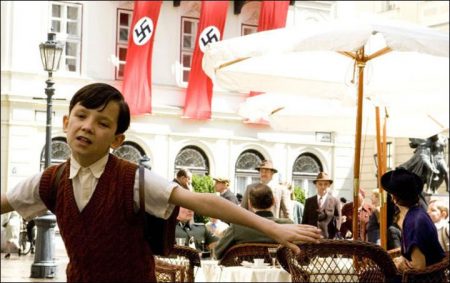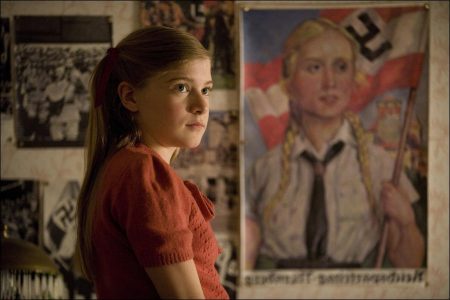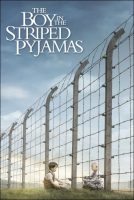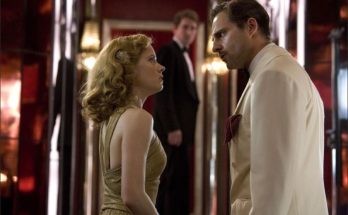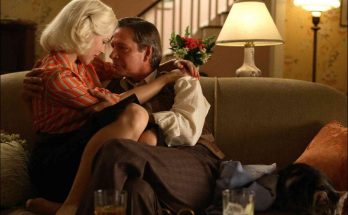Eight year-old Bruno is the sheltered son of a Nazi officer whose promotion takes the family from their comfortable home in Berlin to a desolate area. Bruno ignores his mother’s repeated instructions not to explore the back garden and heads for the `farm’ he has seen in the near distance. There he meets Shmuel, a boy his own age who lives a parallel, alien existence on the other side of a barbed wire fence.
Berlin, 1940s. Eight year-old Bruno returns from playing with his school friends to find his home bustling with preparations: his father, a Nazi officer, has just been promoted and his mother is planning a party. Bruno sees no cause for celebration; his father’s new job is outside Berlin and the whole family will be moving to the countryside, forcing him to leave the home and friends he loves.
His fears of loneliness are confirmed when the family arrives at their dreary, isolated new house. Bruno finds it difficult to settle into his new life and quickly grows bored. There are no other children to play with and his mother forbids him from exploring behind the house. His older sister Gretel never bothers to talk to him anymore: she is too busy organizing her dolls, or talking to one of her father’s men, the handsome, menacing young Lieutenant Kotler.
Bruno is intrigued by the existence of an odd sort of farm he can see from his bedroom window, where all the residents seem to be wearing striped Pajamas. When he tries to find out more about the ‘farm‚’ he is told not to concern himself with it and certainly not to go near it.
We know what Bruno does not, that the `farm’ is an extermination camp. His mother is also in ignorance – she believes that they are living next to an internment or labour camp; her husband has sworn under oath never to reveal its real purpose as a killing factory designed to implement the `Final Solution’, the systematic eradication of the Jewish people.
The Genesis of the Film
The Boy in the Striped Pajamas is a fable intended to provide a unique perspective on the effects of prejudice, hatred and violence on innocent people, particularly children, during wartime. Through the eyes of a fanciful, eight year-old German boy who is largely shielded from the realities of the war, we witness a forbidden friendship that develops between Bruno, son of a Nazi commandant, and Shmuel, a Jewish boy imprisoned in a concentration camp. Although physically separated by a barbed wire fence, the boys’ lives become inescapably intertwined.
“It goes without saying that a work of fiction set in the time and place of the Holocaust is contentious and any writers who tackle such stories had better be sure of their intentions before they begin. This is perhaps particularly important in the case of a book written for children,” says John Boyne, author of the bestselling novel The Boy in the Striped Pajamas. “For me, a 34-year-old Irish writer, it seemed that the only respectful way to approach the subject was through innocence, with a fable told from the point of view of a rather naive child who couldn’t possibly understand the horrors of what he was caught up in. I believe that this naiveté is as close as someone of my generation can get to the dreadfulness of that period.”
Boyne continues: “What happens in this place? Bruno wonders. Why are there so many people on the other side of the fence? Simple questions, perhaps, but at a basic level, aren’t these the questions we still ask? And perhaps that’s the job for any writer or artist, to keep looking for answers, to make sure those questions continue so that no one ever forgets why they needed to be raised in the first place.”
David Heyman, the producer behind the Harry Potter franchise, had circled around the novel THE BOY IN THE STRIPED PAJAMAS although it was director and screenwriter Mark Herman who optioned the book. When he and Herman met and discovered that they had similar thoughts and sensibilities about the project, they decided to work together. Both of them recognized that a work of fiction set within the context of the Holocaust is controversial territory but they were passionate in their response to the story as a compelling and accessible human drama with a perennially important message. They agreed with Boyne that every attempt to explore the dark heart of the Nazi era in the effort to enlighten new generations so that they neither forget nor repeat what happened is not only valid but also necessary.
“One of Graham Greene’s characters says that hate is a failure of imagination,” says David Heyman. “I firmly believe that and I also believe that the enormity of the Holocaust – the scale of the barbarity, the number of the dead and displaced and exponentially, of the lives destroyed – makes it impossible to get the measure of because the figures are frankly inconceivable. If you are trying to introduce a child to that not-so-distant period in time, those numbers are extremely distancing. I think John Boyne found an exceptionally emotive and effective way to address that by focusing his story on two boys and one family.”
Heyman continues: “I’m drawn to human stories, and this is first and foremost a human tale. Whilst it is a Holocaust story set in 1940s Germany, for me, it’s timeless. With all the conflicts going on today, whether in Rwanda, Somalia, Palestine, Israel, Darfur, Zimbabwe or Iraq, this story seems to me to be as relevant today as at any time in history. It’s one that resonates with me and has touched thousands of readers around the world. That children have the potential and the ability to overcome differences in culture and identity; that people ultimately can get along if they’re not encouraged to hate; that governments, institutions and the media can and do cultivate conflict and distrust – these are timely ideas with universal relevance and I think this story makes them accessible to anyone.”
“The Nobel Laureate Elie Wiesel says if you weren’t there, don’t write about it,” says author John Boyne. “And to a point, I agree with that. At the same time, we’re told that we must never forget. So I believe that, as the decades go on, it is up to artists to find new ways of telling this story, of reminding the world of those who died. If you approach the subject in a non-exploitative way, trying not to trivialize it but to tell the story another way to reach a new audience, you are accomplishing your goal. I always tell children who have read my book `If you were moved by it, if the story of these two boys is interesting to you, here’s a list of books you should read.’ And those books are by people such as Wiesel, Primo Levi and Anne Frank – writers who experienced the Holocaust and have the moral authority. I hope that artists today can do that: get children interested and direct them to the books they should be reading.”
Every member of the production team behind The Boy in the Striped Pajamas is very clear that they were filming a work of fiction and not a documentary. Nevertheless, as the story draws from history, meticulous care was taken to respect the historical context. “We were extremely concerned with authenticity,” says Mark Herman. “When researching the adaptation, I learned that the camp commandants were sworn to secrecy under threat of certain death to keep their activities top secret. They were forbidden to tell anybody, including their own families, what their `work’ entailed.
This was helpful when writing the script, particularly to explain why the commandant hadn’t told his wife about the extermination program – she thinks it is a labour camp and only accidentally discovers the truth. An audience today has the benefit of historical hindsight – certain things would be obvious to them. It would seem to an audience today that surely the wife knew; she’s living next to a concentration camp, surely she knew. But some of them didn’t know. The commandant’s wife at Auschwitz, for example, was living virtually on top of the camp without knowing it was a death camp for two years. The fascination of the story is that these two boys, from either side of the fence, don’t actually know what’s going on.”
“Mark has intensified the drama of the family and brought in this adult viewpoint of the Mother gradually discovering what is going on in the camp which was much less developed in the book,” says co-producer Rosie Alison of Heyday Films who coordinated the historical research for the film. “He also added a Nazi propaganda film which emerged from our research, a repellent 14-minute short purporting to show life in the camps: recreational activities, convivial dining, smiling faces. Mark decided to shoot a version for the film so that Bruno has a few glimpses of it and thinks he knows what the camp is like because he’s seen the footage and it looks quite nice. This slightly and briefly renews his faith in his father.”
Alison continues: “This is a story based on history and we were careful to treat that history with respect,” she says. “It’s a very oblique drama – everything is seen from the other side of the fence until the very end and the reality of the camp is kept out of sight until the closing scenes. The most controversial aspect of the story, perhaps its greatest use of artistic license, is Shmuel’s presence in the concentration camp. It is probably the area where fiction and truth separate the most in our film because the unimaginably horrible fact is that most children arriving in the camps were immediately sent to their deaths.
By 1944, however, particularly in Auschwitz, there were children still surviving and there are individual cases of children kept alive, whether for medical experiments or for specific jobs (such as a documented instance of two boys kept at Treblinka to feed the ducks in the pond). There are famous photographs of child survivors at the liberation of the camps but it is true that they were generally taken straight from the transport into the gas chambers and Shmuel’s story therefore requires a suspension of disbelief.”
“History has a pattern of repeating itself and I think that it’s very important that these stories are told, in whatever form and by whomever, as long as the emotional content is real and true,” says producer David Heyman. “This is the story of an ordinary family, ordinary people who through ignorance, innocence or unquestioning obedience to authority – no matter how appalling the demands of that authority – recognizably embody Hannah Arendt’s `banality of evil’. I hope that young people and other audiences will be moved by The Boy in the Striped Pajamas and come away with a greater understanding of the personal cost of such tragedy and their kinship with the participants – perpetrators and victims alike.
The film was made with honesty, passion and conviction by people who have great respect and admiration for those who survived, and great respect and admiration for those who did not. I do think it is very important to keep this story alive so we don’t repeat it and anything we do to this end, any step we take to make one person look at the world a little bit differently I think is worth taking.”
Cast and Characters
“We saw hundreds of young actors for the role of Bruno, the camp commandant’s son,” says director Mark Herman. “Asa Butterfield’s was the first tape I received and he was the third person I saw. I thought he was fantastic but we kept on searching, just because we wanted to make sure that no stone was unturned. In the end, we went back to him because the crucial thing was to find a child who can hold the screen. Asa does that. And he has just the right blend of innocence and curiosity for the role, and such compelling, watchful eyes.”
“Mark helped me a lot by telling me when to do what,” says 10 year-old actor Asa Butterfield matter-of-factly. “The only thing I don’t like about making films is having to do scenes over and over again, but I guess that’s what filming is about!” Before getting the part, Asa knew something of the historical context of the story. “Some of it I already knew about,” he says. “But I didn’t know that it was called the Holocaust. I nearly cried when I read the script.”
For the casting of Shmuel, the Jewish boy on the other side of the fence, Herman says: “I saw Jack Scanlon quite late in the process of seeing hundreds of boys. Jack can be moving without being sentimental; he has a natural dignity about him. But I had to see who had the right chemistry with our Bruno before choosing an actor to play Shmuel. Having narrowed it down to about three boys, we tried different pairings with Asa. Jack and Asa played very well against one another.”
Eight year-old Jack Scanlon makes his feature film debut in the role of Shmuel. His potted history of the period runs as follows, complete with a conclusion that demonstrates his perfectly accurate grasp of the injustice wrought upon the victims: “The Germans lost quite badly in the First World War to the English. So Hitler got back at them by getting all the Jews, and people who were against him and his countrymen, and putting them into these things called `ghettos’. Then they brought them into the camps. And Bruno thinks it’s because the Jews are the best workers. But really, Hitler just puts them there because it’s like a punishment. But really it’s not, because what have they done wrong?”
For the role of Bruno’s sister Gretel, Herman chose young actress Amber Beattie. “She was stunning in the auditions,” recalls Herman. “And, as with Asa, Amber became the yardstick for other potential Gretels to measure up to. Nobody ever did – she was ahead of the pack all the way. Amber has a plucky directness about her, and as Gretel, although she disdains Bruno and is seduced by the Hitler Youth, as the story progresses she manages to retain our sympathy.”
Young teenager Amber Beattie is part of the core audience for The Boy in the Striped Pajamas. She wept while reading the book and on seeing the film for the first time, and took away a simple but essential message from the story: “I think the lesson in the film is don’t judge other people, treat everyone as an equal. Because, really, everyone else is the same as you.”
Producer David Heyman was impressed with Mark Herman’s rapport with his cast and in particular, appreciated his skill in communicating with its younger members. “It’s very easy to pander or to patronize,” say Heyman, “but Mark didn’t do that. He treated the kids as mature people with their own thoughts and ideas; he treated them with the respect they deserved and required and I think the children responded accordingly. I think they realized that they were doing something serious and dramatic, something that demanded effort and attention, and had worth and value. As a result, they treated the work with the same respect Mark gave to them. Mark Herman is a very compassionate director – he has a real sympathy for the characters he writes about and the actors he directs.”
American actress Vera Farmiga plays Elsa, Bruno’s mother, the commandant’s wife. Director Mark Herman was keen to exploit the chameleon quality that previously brought her to the attention of directors such as Martin Scorsese and Anthony Minghella: “What attracted me to Vera is her total immersion in every role she plays. She’s so different – almost unrecognizable – in every film I’ve seen her in. She turned up every morning on our set as this 1940s lady completely unrecognizable as Vera Farmiga. She has a very European look and she is a wonderful actress – she captures the moral ambiguity and brings a very particular humanity and sympathy to the role of the commandant’s wife who only gradually learns of the gas chambers. I think that Vera and David lifted the film onto a different level than even I had expected.”
Vera Farmiga researched her part extensively and her interpretation of Elsa is an amalgam of all of the diaries and journals she’d read: “It’s a sort of a compilation of all of the women in the Third Reich, from Paula Hitler to Emmy Goering to Magda Goebbels to Eva Braun to Leni Riefenstahl – all of them. I also spent lots of time looking into the propaganda of motherhood, the cult of motherhood, and what that meant – what women strove to be as mothers and what their position was throughout that period of time.”
“In a sense, Elsa is the guardian of the fence; it’s her mission to hide its existence and what lies beyond it, and when Bruno discovers the fence, it’s her mission to deter him from exploring it,” says Farmiga. “There is a line of dialogue in the novel that, for me, is the key to Elsa’s character: shortly after they’ve arrived at the camp house, Bruno says, `I think this was a bad idea’. And his mother replies: `We don’t have the luxury of thinking’.”
Farmiga continues: “Elsa doesn’t think. She doesn’t think for herself, she doesn’t think deeply. She chooses to be oblivious, concerning herself only with the safety of her family and her position in society – everything else is beyond her periphery. She’s a sort of accomplice and assistant to her husband’s ideals, his desires, his morals and his ambitions. But as she starts to open her eyes to what is unfolding, as she starts to explore for herself, there is a gradual decline of tenderness, trust and respect for her husband. And eventually she stands up and says No! Eventually, she condemns what’s going on. She even tries to get her husband to see the evil that he’s responsible for. But it’s too late – in the end, I think this willful refusal to see what’s going on right under her nose and beyond the fence costs her a life. In a sense, she is the author of her child’s fate because it’s too late by the time she starts inquiring. She has intuitions; she knows that people are being horribly mistreated. But she doesn’t look; she doesn’t want to see it because seeing it would implicate her husband, and it would implicate herself.”
Farmiga believes that the film will engage and challenge today’s audience on many levels: “Elsa’s character, with her initial indifference, apathy and ignorance is crucial to the question of how so many people could have been murdered under the eyes of the world without anyone knowing about it. Because it’s happening all over the world. It could just as easily have been set in Iraq or Afghanistan or Kosovo or Darfur. This racial hatred exists. ”
David Thewlis plays Bruno’s father, the camp commandant. “I’ve always been a big fan of David’s,” says Herman. “His role is one of the trickiest in the film, because in the first half he has to come off as a loving, human father. Yet our viewers will know who this father really is. It’s a very difficult acting job, to play this normal family life. David’s fantastic in that warm side. It sort of makes you wonder about the hidden dark side of anyone who seems family-minded like him.”
“I think the difference with this script is that it’s seen from a German point of view, through the eyes of a German child. In the beginning, it looks like the part I’m playing, that of a loving father (and it’s immediately apparent what he’s really doing) might be showing some sympathy,” says David Thewlis. “The challenge is not to play a clichéd, two-dimensional evil Nazi. In my research, I came to learn that my character was very much based on fact. We do not say which camp it is in the film but it’s obviously not Auschwitz because I would then be playing Rudolf Hoess who had five children and raised them in the middle of Auschwitz, within sight of the crematoria. And it’s not Joseph Goebbels whose six children were taken down into the bunker at the very end of the war and were poisoned by Goebbels and his wife, who then killed themselves. It’s not at all unthinkable that such a story as this could happen. It’s a piece of fiction but it’s based on plausible situations. We increase the distance of our `film’ house from the camp but in reality, they were a matter of yards away.”
Thewlis continues: “I don’t think I’ve researched a film as much as this for years because I felt a great duty to do that. Usually, I take someone from my own life, someone I’ve met at some point and think, that person could have been like this person. How can I apply those characteristics? Whereas I’ve never met anyone who at all resembles the character I’m playing here because it’s quite unimaginable to understand how one could be a loving father – I’m sure he is a loving father – and at the same time, leave your children at breakfast, go next door – literally- and spend your day amidst these terrible, terrible, terrible atrocities. How do you get your mind set into that?”
Like Vera Farmiga, Thewlis read many personal documents written by the architects and perpetrators of the Final Solution in preparation for his role as a camp commandant: “I was given a letter that Rudolf Hoess wrote to his children just before his execution. It was lying around at home, on my kitchen table, and I had some neighbours over. I hadn’t told them what I was working on. They saw this letter lying around and started reading and when they’d finished it, they turned to me and said, `Oh, what a beautiful, heart-rending letter this man has written to his children! Who was he? Why was he dying? Was he sick?’ To which I replied, `Yeah, he was VERY sick!’ But the letter is clearly written by a man with an intense love for his children; it’s very articulate, very touching, almost poetic. Try and understand a human being – a sensitive human being – but one who’s capable of this! No way can I find it in myself to justify or forgive, obviously. But my job was to somehow find the humanity in him, and not to see all these people – as the cliché goes – just as monsters. They were human beings. And there are people out there today that are just like him.”
“To me, The Boy in the Striped Pajamas is interesting on many levels,” says Thewlis. “There’s my part which is quite straight forward; then there is my wife who accepts the idea of a prison camp but slowly comes to realize that I’m actually engaged in genocide and then we see the effect that has upon our marriage. You have my daughter, Gretel, seduced by the rhetoric, the politics, The Fatherland. Her flirtation with the young soldier is almost an ideological seduction. My father is fully behind The Reich but my mother is thoroughly opposed to everything Fascism stands for and she’s very vocal about it. So within this one family, you’ve got five or six different points of view that evolve throughout the film, and then of course, you have Bruno whose point of view shifts several times during the course of the story until the very end. To see the film as a fable is to see the disintegration of the family, and hopefully, therein lies the punishment for the father’s sins.”
For the role of Lieutenant Kotler, Mark Herman chose young British actor Rupert Friend. “He’s one of those actors who can go either way,” says Herman. “He can play very gentle and very nasty. And in this role, he is very nasty. He does a fantastic and powerful job with it – he is very chilling and dangerously seductive. We understand that a girl Gretel’s age could be attracted to him and what he represents. At the same time, Rupert manages to expose Lt. Kotler’s extreme vulnerability under her father’s interrogation at the dinner table.”
Lt Kotler is the catalyst for Gretel’s romance with Nazi ideology (memorably described by Sir Hugh Trevor-Roper as `a vast system of bestial, Nordic nonsense’) as well as the destruction of the camp commandant’s marriage. Friend describes his character as a member of the “inner circle” of the family: “It’s Kotler who betrays to the mother that what they’re doing is burning the bodies of the Jews,” he says. “And the father therefore blames Kotler for the complete disintegration of his happy family. Of course, the father is the one overseeing the atrocities but he blames Kotler because his wife didn’t know before Kotler blurted it out. It’s the end of Kotler’s career because the father sends him to the front line which was tantamount to a death sentence.”
Along with his fellow cast members, Friend devoted himself to researching his part through the study of first-hand accounts and other documents that would provide even a glimpse into the workings of the minds of the murderers: “It’s very sensitive subject matter and for that reason, it needed to be handled with great sensitivity by all parties,” he says. “My main challenge was to find a way of understanding the mind-set of the Nazi Party, to understand why somebody would follow the order to engage in genocide, blindly and without question. Amongst many things, I read a biography of the Commandant of Auschwitz, Rudolf Hoess, and a wonderful memoir of a girl who lived on Hitler’s mountain. I also read about the psychology of war, and the way soldiers approach the act of killing. The terrifying thing about the people who committed these crimes is that they were human beings – they were real, thinking, breathing men. They weren’t deranged. They perhaps didn’t have the same moral compass as we do but they were by no means anything other than men. I think it’s important to see them, not in any way sympathized with, but at least given humanity so that we are reminded that we are only ever a step away from an atrocity like this at any time.”
Like John Boyne, the author of the novel, actor David Hayman who plays Pavel, the gentle inmate and kitchen helper, had visited the camp at Auschwitz: “I toured Poland with a theatre company many, many years ago and I went to Auschwitz,” he says. “It had an extraordinarily profound effect on me. They say that the birds don’t sing and the flowers don’t grow in Auschwitz. It’s not a cliché. It’s true. You come out of there and it’s like something has clung to you. You come out wanting to do something, anything to strip away the horror of what you feel. I think that every single school child on this planet should be taken to Auschwitz and told: `That’s man’s inhumanity to man’. That is what we are capable of and it must never be allowed to happen again.’ Unfortunately, it does happen. It is happening.”
The Look of the Film and Filming Locations
The entire behind-the-scenes creative team, including cinematographer Benoit Delhomme, production designer Martin Childs and costume designer Natalie Ward was committed to bringing authenticity, respect and attention to detail to capture one of the darkest periods in history.
The emotional resonance and impact of the shoot, particularly for the Hungarian crew, can not be underestimated. “The crew was constantly and acutely aware of Hungary having supported Germany during both World Wars, and understood the specificity of the story to the 1940s,” says producer David Heyman. “They have lived through officious, authoritarian regimes, and I think they were very sympathetic to all the contemporary echoes of that era. I always sensed the passion that our crew had for this particular job.”
Cinematographer Benoit Delhomme had read the book at one sitting, and had a passionate commitment to bring the story to life. “This is not a film about pretty pictures,” says David Heyman, “and Benoit brilliantly realized the moments of discomfort, the awkwardness as well as the beauty. Sometimes the frame’s a little messy; you’ve got the head of a character in the foreground, blurred. It’s not always very neat, but at the same time, it’s appropriately, eloquently shot.”
“When I began this picture,” says production designer Martin Childs, “Budapest had already been selected and I made my first trip there to see what kinds of locations were available to us. It was a very reassuring visit. I knew we had a lot of work to do to get it right but the city has an innate, Middle European `rightness’ already. ‘In the script, the sets seemed to design themselves; the story has a very clear geography, with contrasting places, which worked out the architecture for me; which worked out the relationship of all the spaces, how they worked with one another.’
For example, the opening scenes in the film are part of a montage of Bruno and his friends running through the streets pretending to be Messerschmitts. They’re seduced by the `glamour’ of the war and they are on their way home from school. I wanted their journey to be through several different neighbourhoods – the wealthier parts of Berlin and the parts that their mothers wouldn’t approve of. We didn’t want a montage of heritage sites, but rather we wanted to get several social strata into the opening sequence of the film.”
“Early on, I knew I’d have to build the camp house,” says Childs. “You go through the motions of trying to find something that works, but in the end we built it from the ground up, by a forest, which is what the story needed. The concentration camp itself needed to be carefully researched because you discover that there was a great deal of variety from one to another – although all with the same purpose. We were very careful in our design for the fence where Bruno and Shmuel meet, with the brown and grey background behind Shmuel and the bright, green forest behind Bruno. As the story was told from Bruno’s point of view, I spent a lot of time at his level, getting down on my knees to imagine the sets.”
“It had to feel real, it had to feel genuine so that the viewers believe they are planted firmly in that world,” says costume designer Natalie Ward. “It’s not something that needs an imaginative slant to it because you want the audience to recognize these people. This period has been filmed a lot but even though you think you know what it looks like, you want to get it completely right. Once you start focusing on the details, and you realize you don’t know as much as you thought you did. Consequently, I asked thousands of questions and did a lot of research.”
Regarding the sets for the final scenes in the film, designer Martin Childs knew he required the highest degree of authenticity. “For the set of the anteroom to the gas chamber and the gas chamber itself, I had to do a forensic amount of research, and some very unpleasant research,” he says. “There’s a famous photograph of the gas chamber at Auschwitz which bore an uncanny superficial resemblance to the basement underneath the studio where we were shooting a few scenes. We were able to modify it and – mercifully – we did not have to build a gas chamber from the ground up.”
“There’s a huge amount written now, and a lot of documented evidence collected by archivists and Jewish groups trying to put the Holocaust into some kind of context. As a subject and a period in history, a great deal of accurate reference material exists,” says supervising art director Rod McLean. “Alain Resnais’s 1955 documentary “Night and Fog” made a particularly strong impact. Nothing prepares you for that. So while there is a lot of research material available, the images and descriptions have lost none of their power to shock; you needed to leave it for a few days to re-group. ”
Budapest, the capital of Hungary, was chosen as the location for the film primarily because the geography of the city and the surrounding suburbs suited the visual and cinematic needs of the story and the production. The budget incentives and the availability of top-notch local crew members and studio space cemented the deal. What the filmmakers hadn’t anticipated was the extremely visceral emotional reaction of many of the cast and crew members to filming this particular story in a country where the atrocities depicted and referenced actually took place, when the chaos of WWII overtook the country and its populace in horrific ways.
Situated on both banks of the Danube River, Budapest unites the hills of Buda and the boulevards of Pest. Although some 30,000 buildings were destroyed during World War II and later during the1956 Revolution, the past lives on in the architectural detail of the structures that remain. The city has served as a location for many international productions, doubling as London, Paris, East and West Berlin, and even Buenos Aires.
After an extensive search, it was director Mark Herman, returning from a recce, who happened on the location for the Berlin house exterior on a busy road in the Budapest district of Zugló. The interiors of the house were filmed in the restored Sacelláry Castle, situated in Budapest’s XXII district, in Budafok.
A complex of tenement buildings, effectively a city within a city, was used for the Nazi round-up of Jewish residents in the opening montage. The schoolboys, pretending to be bomber pilots, fly through an elegant square directly behind the Kempinski Hotel and pass through the area adjacent to the Opera House.
Having scoured the immediate area looking at everything from hunting lodges to train stations, director Mark Herman and production designer Martin Childs decided to build the exterior of the commandant’s camp house on the grounds of the orphanage at Fót, known as the “Children’s City”. The woods of the “Children’s City” were used for Bruno’s passage to and from the fence where he meets Shmuel.
The barracks where the scenes in the concentration camp were filmed were originally built as a set for John Houston’s “Escape to Victory”. Since then, they have been modified many times to suit the needs of various Hungarian and international productions.
Sets for the children’s bedrooms were built in the newly renovated Lloyd Studio. The final weeks of shooting took place on the sound stage at Mafilm’s Róna Street Studio.
The Boy in the Striped Pajamas (2008)
Directed by: Mark Herman
Starring: Sheila Hancock, David Heyman, Asa Butterfield, Cara Horgan, Amber Beattie, Vera Farmiga, David Thewlis, Richard Johnson, Béla Fesztbaum, Iván Verebély, Jack Scanlon
Screenplay by: Mark Herman, John Boyne
Production Design by: Martin Childs
Cinematography by: Benoît Delhomme
Film Editing by: Michael Ellis
Costume Design by: Natalie Ward
Set Decoration by: Gábor Nagy
Art Direction by: Rod McLean, Razvan Radu, Szilvia Ritter, Mónika Esztán
Music by: James Horner
MPAA Rating: PG-13 for some mature thematic material involving the Holocaust.
Distributed by: Miramax Films
Release Date: November 7, 2008
Visits: 102
